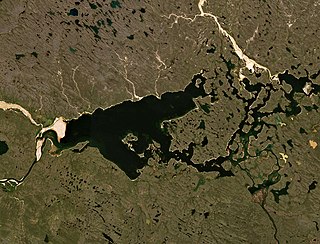
Pond Inlet is a small, predominantly Inuit community in the Qikiqtaaluk Region of Nunavut, Canada, located on northern Baffin Island. To the Inuit the name of the place "is and always has been Mittimatalik." The Scottish explorer Sir John Ross had named an arm of the sea that separates Bylot Island from Baffin Island as Pond's Bay, and the hamlet now shares that name. On 29 August 1921, the Hudson's Bay Company opened its trading post near the Inuit camp and named it Pond Inlet, marking the expansion of its trading empire into the High Arctic.

The Inuvialuit or Western Canadian Inuit are Inuit who live in the western Canadian Arctic region. They, like all other Inuit, are descendants of the Thule who migrated eastward from Alaska. Their homeland – the Inuvialuit Settlement Region – covers the Arctic Ocean coastline area from the Alaskan border, east through the Beaufort Sea and beyond the Amundsen Gulf which includes some of the western Canadian Arctic Islands, as well as the inland community of Aklavik and part of Yukon. The land was demarked in 1984 by the Inuvialuit Final Agreement.

Tuktut Nogait National Park is a national park located in the Northwest Territories of Canada that was established in 1998. Meaning "young caribou" in Inuvialuktun, the park is home to the calving grounds of the Bluenose-West caribou herd.

Bathurst Inlet,, is a small Inuit community located in Bathurst Inlet in the Kitikmeot Region of Nunavut, Canada.

The barren-ground caribou is a subspecies of the reindeer that is found in the Canadian territories of Nunavut and the Northwest Territories, in northern Alaska and in south-western, Greenland. It includes the Porcupine caribou of Yukon and Alaska. The barren-ground caribou is a medium-sized caribou, smaller and lighter-colored than the boreal woodland caribou, with the females weighing around 90 kg (200 lb) and the males around 150 kg (330 lb). However, on some of the smaller islands, the average weight may be less. The large migratory herds of barren-ground caribou take their names from the traditional calving grounds, such as the Ahiak herd, the Baffin Island herds, the Bathurst herd, the Beverly herd, the Bluenose East herd, the Bluenose West herd, the Porcupine herd and the Qamanirjuaq herd.
The Burnside River is a river in the Canadian territory of Nunavut. It has its headwaters at Contwoyto Lake, flows across the Precambrian Shield's Contwoyto Plateau, flows through isolated and rugged tundra, into Lake Kathawachaga, and through the Wilberforce Hills region. Before emptying into Bathurst Inlet on the Arctic Ocean, the Mara River empties into the Burnside River. The river has an island, Nadlak, historically notable for Inuit use of caribou antlers as hut roof infrastructures.
Contwoyto Lake is a lake in the Kitikmeot Region of the Canadian territory of Nunavut, located near the border with the Northwest Territories. With a total area of 957 km2 (369 sq mi), it is the territories' tenth largest lake.

Kugluk/Bloody Falls Territorial Park is located about 15 km (9.3 mi) southwest of Kugluktuk, Nunavut, Canada. The 10 ha park is situated around the Bloody Falls on the Coppermine River and was listed as a national historic site in 1978.

Amadjuak Lake is a lake in the Qikiqtaaluk Region, Nunavut, Canada. Along with Nettilling Lake, it is located in south-central Baffin Island's Great Plain of the Koukdjuak. It is 154 km (96 mi) south of Burwash Bay. The closest community is Iqaluit.

Beverly Lake is a lake in the Kivalliq Region, Nunavut, Canada. It is located north of the Arctic tree line about 150 km (93 mi) northwest of Baker Lake, Nunavut. The western half of the lake is within Thelon Wildlife Sanctuary. The Thelon River, at the confluence with the Dubawnt River, empties into the lake's southwestern bank. The Kazan River empties into the Thelon River at Beverly Lake's southeastern bank, between Beverly and Aberdeen Lakes. A delta occurs on the Beverly Lake's southern edge, which includes the Isarurjuaq Peninsula.
Ferguson Lake is a lake in Kivalliq Region, Nunavut, Canada. It is located 150 km (93 mi) north of the tree line, midway between Yathkyed Lake and Qamanirjuaq Lake. The lake's outflow is to the east into the Ferguson River, which flows eastward through several lakes, emptying into northwestern Hudson Bay between Rankin Inlet and Whale Cove. The closest community is Baker Lake, 160 km (99 mi) to the north.
Qamanirjuaq Lake formerly Kaminuriak Lake, pronunciation: ka-min-YOO-ree-ak; meaning: "huge lake adjoining a river at both ends", is a lake in the Kivalliq Region, Nunavut, Canada. It is the first of several named lakes on the eastward flow of the Ferguson River through the eastern barrenlands. The lake is located about 2 km (1 mi) downstream from Ferguson Lake, and adjacent upstream to Parker Lake South. The Ferguson River passes through a series of rapids before entering the western arm of Qamanirjuaq Lake.
Mary River is located on Baffin Island in the Qikiqtaaluk Region of Nunavut, about 936 km (582 mi) northwest of the capital, Iqaluit, and about 176 km (109 mi) southwest of Pond Inlet Inuktitut: Mittimatalik, lit. 'the place where the landing place is' The Inuit, name for the Mary River mountain is Nuluyait, meaning buttocks. There is a 4,000 year history in the area. For hundreds of years the semi-nomadic Inuit from the region that includes the hamlets of Pond Inlet and Igloolik, met at Mary River during the summer hunting caribou. By 2011, the population of the region was about 5,400 people, many of whom continued the traditional hunting and fishing lifestyle living off the land.
The Banks Peninsula is located on the mainland of Canada's Nunavut territory. There are no communities on the peninsula, though the hamlet of Bathurst Inlet is located close by, to the south, across the waterway of Bathurst Inlet. The peninsula has an irregular coastline, including a portion bounded by Arctic Sound. Point Wollaston is the northernmost geographic feature.

Hornaday River is a waterway located above the Arctic Circle on the mainland of Northern Canada.
The Mary River Mine is an open pit iron ore mine on Inuit Owned Land (IOL) operated by the Baffinland Iron Mines Corporation (BIMC), in the Mary River area of the Qikiqtaaluk Region, on Baffin Island, Nunavut, in the Canadian Arctic Archipelago. As of 2021, Mary River mine operation consists of an open-pit mine, two work camps for hundreds of workers, a tote road—from the Mary River site to Milne Inlet—and a port infrastructure at Milne Inlet. According to a 4-year study published in 2008, the Mary River Mine, with its four massive iron ore deposits of 65-70% pure iron ore was "one of the most promising undeveloped iron deposits on the planet". It was not until technological advances were in place in 2010, and the market for iron ore had dramatically increased that sizable financial backing for the high cost of development in a remote region known for its inhospitable climate, was available. The mine began operations in 2014, and the first shipment to Europe arrived in 2015. Baffinland is currently planning on expanding the mine. In February 2021, a group of Inuit hunters blockaded access to the mine for a week to protest the expansion.

Dolphin and Union Caribou, Dolphin and Union caribou herd, Dolphin-Union, locally known as Island Caribou, are a migratory population of barren-ground caribou, Rangifer tarandus groenlandicus, that occupy Victoria Island in the Canadian Arctic Archipelago and the nearby mainland. They are endemic to Canada. They migrate across the Dolphin and Union Strait from their summer grazing on Victoria Island to their winter grazing area on the Nunavut-Northwest Territories mainland in Canada. It is unusual for North American caribou to seasonally cross sea ice and the only other caribou to do so are the Peary caribou who are smaller in size and population. They were listed as Endangered by Committee on the Status of Endangered Wildlife in Canada (COSEWIC) since November 2017.
Caribou herds in Canada are discrete populations of seven subspecies that are represented in Canada. Caribou can be found from the High Arctic region south to the boreal forest and Rocky Mountains and from the east to the west coasts.

The reindeer is a widespread and numerous species in the northern Holarctic, being present in both tundra and taiga. Originally, the reindeer was found in Scandinavia, eastern Europe, Russia, Mongolia, and northern China north of the 50th latitude. In North America, it was found in Canada, Alaska, and the northern contiguous USA from Washington to Maine. In the 19th century, it was apparently still present in southern Idaho. It also occurred naturally on Sakhalin, Greenland, and probably even in historical times in Ireland.
The Bathurst Inlet Port and Road Project is a plan to build an all-weather road from Bathurst Inlet in Nunavut to a complex of mines that are approximately equidistant between Bathurst Inlet and Yellowknife, NWT. There are no paved roads between Yellowknife and the mines, so they have relied on shipping supplies to the mines over winter-time ice roads. However, in 2005, there was a particularly warm winter, and the ice roads weren't safe for a long enough period to bring in supplies.












